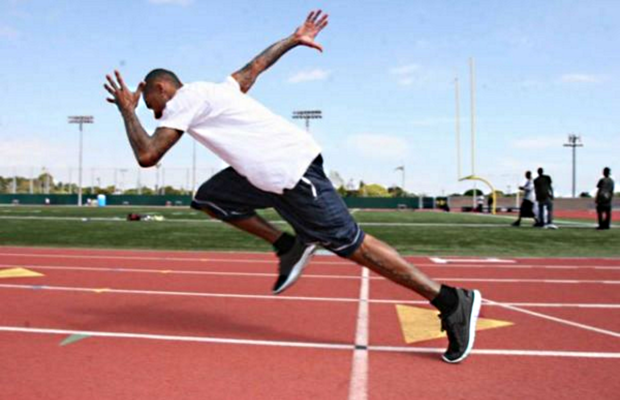3 Reasons Why Every Football Player Should Run Track

Co-authored by Lucas Kurtz.
If you strap on a helmet in the fall, you should be lacing up spikes in the spring.
This should seem obvious. After all, the quickest way to impress a football scout or coach is to be the quickest guy in a 40-Yard Dash. “The 40” is probably the most closely-watched drill at any combine, and posting a head-turning time can mean the difference between having multiple scholarship offers and fighting for preferred walk-on status. (Check out STACK’s Guide to Beating the 40-Yard Dash.)
But running track won’t just help you during recruiting. It will make you an all-around better athlete, improving your on-field performance in three ways.
You’ll Find Your Fastest Running Form
Nobody knows the in’s and out’s of speed like a track coach. After all, there aren’t many variables in track—you are running in a straight line. So one small blip in your form can make or break a race. So track coaches place huge emphasis on technique to maximize speed. Refining your technique on the track is a great way to make perfect running form second nature, so when game day comes on the gridiron, you’ll be able to run faster without having to think about it. (Master the four points of good running form.)
You’ll Build a Better “Burst”
Athletes who run track continually work on their starting stance, and with good reason: a runner’s speed “out of the blocks” has a lot of influence on their finishing time. An athlete can trim a tenth or even two-tenths of a second off their 40 time just by getting their start down cold.
Added bonus for footballers: the action of coming out of the starting blocks is very similar to getting off the line of scrimmage. Both require you to generate speed and power from a dead stop. So improving your “burst” at the starting line will improve your burst off the ball.
In addition, an often overlooked but very important skill in football is the ability to accelerate from half- to full-speed, as when receivers run passing routes or cornerbacks make a break on the ball. Track teaches you to get to your top speed as quickly as possible. Common track drills, like Flying Starts, increase stride frequency and improve body control when transitioning to max speed.
You’ll Get More Speed with Less Effort
Most football players are all about force, running like bowling balls trying to knock pins down. Sprinters, on the other hand, look like they almost glide over the ground. A good track coach will teach you to relax your body and exert the minimal amount of force necessary to attain top speed. Not only will you run faster, you won’t be as exhausted after a play.
Coaches often prescribe long sprints of 200 to 400 yards with short rest periods (about 45 seconds) between them. The short recovery time forces you to find your most efficient stride and arm swing to avoid fatigue.
Read the original article in Stack.
Top 10 NFL football players who also ran track.
